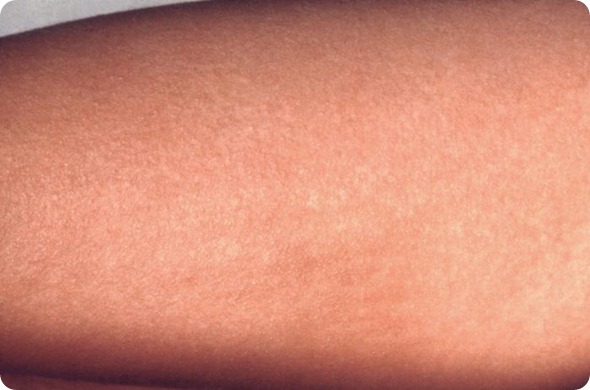What is Scarlet Fever?
Scarlet fever is essentially a bacterial infection that leads to a typical pink-red rash. It is caused by an organism Streptococcus and is seen rarely in developed countries like United Kingdom these days.
Scarlet fever is also known as scarlatina. This is a milder form of the disease. 1-6

This patient revealed a scarlet fever rash on the volar surface of the forearm due to group A Streptococcus bacteria. The scarlet fever rash first appears as tiny red bumps on the chest and abdomen that may spread all over the body. Looking like a sunburn, it feels like a rough piece of sandpaper, and lasts about 2-5 days. Image Credit: CDC
Causes of Scarlet fever
The causative organism is toxin-producing strain of Streptococcus pyogenes (Group A beta-haemolytic streptococci or GpA BHS). Scarlet fever was common and occurred as epidemics in the 1800s. The death rate from Scarlet fever then was as high as 150/100,000.
These days with available antibiotics the severity of the infection has reduced dramatically. There has been a marked reduction in the incidence of Scarlet fever over the last 10 years.
There were 4176 notifications in England and Wales in 2009.
Scarlet fever is one of the initially viral rash associated fevers that were discovered. Others include Rubeola (measles), Rebella (German measles), Dukes' disease (caused by coxsackie virus), Fifth’s disease or erythema infectosum and roseola infantum (caused by herpes virus, HH6).
Scarlet fever was named by Thomas Sydenham (1624-1689), the father of English medicine.
Symptoms of Scarlet fever
The disease is usually mild with characteristic symptom of a whole-body fine pink-red rash that may feel rough on touch.
It may begin in one area and spreads soon to many parts of the body, such as the ears, neck and chest. The rash is accompanied by itching.
The patient usually presents with a flushed, red face giving the disease its name Scarlet fever. The skin around the mouth, however, appears white. The tongue may look a bit like a strawberry and is called the sign of a “strawberry tongue”.
There may be high rise of fever, general feeling of illness and swollen lymph nodes at the neck.
Symptoms usually develop one to four days after a person is infected. Scarlet fever usually follows a sore throat or a skin infection with the bacteria. Up to about 10% of streptococcal (Group A betahemolytic streptococci) sore throats will go on to cause Scarlet fever.
Is Scarlet fever contagious?
Streptococcal infection is very contagious. It is spread in tiny water droplets released in air by the infected person on coughing or sneezing. Healthy people around the infected person may become ill after inhaling the droplets with the bacteria.
Who does Scarlet fever affect?
Scarlet fever commonly affects children aged six to twelve years old. However, all age groups are susceptible to this infection. It may also affect someone who lives in a crowded environment. This is commonly seen among school children, children in a day care etc.
All children or persons exposed to the infection may not go on to develop the condition. Most children over 10 will have developed immunity to the toxins from streptococcal bacteria. This makes them resistant to the infection.
In addition, children less than two years of age are also protected from the infection due to immunity provided to them by their mothers.
Treatment of Scarlet fever
Most cases are mild and easily treatable with antibiotics, which must be taken for 10 days. Most people recover after four to five days.
Pregnant women who catch the infection usually do not have a higher risk to their babies but nearing their due dates this could be a problem and health care providers must be informed.
Complications of Scarlet fever
Complications are rare, but they can include:
acute rheumatic fever (this may damage the heart)
ear infections (also called otitis media)
adenitis or abscess in the throat
pneumonia (lung infections that may be life threatening)
kidney damage (termed glomerulonephritis)
meningitis (infection and inflammation of the membranes covering the brain and spinal cord)
Early treatment reduces the risk of complications.
Sources
- http://www.nhs.uk/conditions/Scarlet-fever/Pages/Introduction.aspx
- www.bbc.co.uk/health/physical_health/conditions/scarletfever1.shtml
- http://www.patient.co.uk/doctor/Scarlet-Fever.htm
- http://www.swsbm.com/EclecticMed/Eclectic%20Medicine_Part_Ib.pdf
- www.usfca.edu/…/SCARLET%20FEVER.pdf
- http://www.windhamsd.org/health/strepthroat.pdf
Further Reading
- All Scarlet Fever Content
- Symptoms of Scarlet Fever
- Causes of scarlet fever
- Diagnosis of scarlet fever
- Treatment of Scarlet Fever
Last Updated: Jun 5, 2019

Written by
Dr. Ananya Mandal
Dr. Ananya Mandal is a doctor by profession, lecturer by vocation and a medical writer by passion. She specialized in Clinical Pharmacology after her bachelor's (MBBS). For her, health communication is not just writing complicated reviews for professionals but making medical knowledge understandable and available to the general public as well.
Source: Read Full Article
